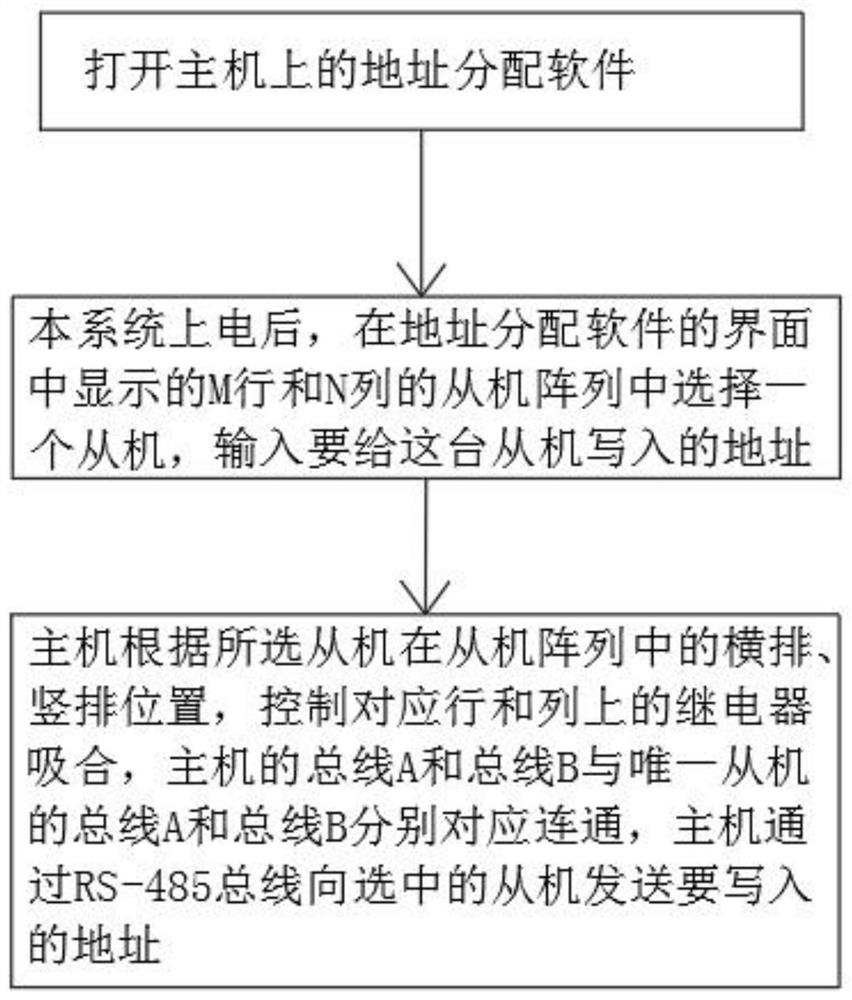Implementation system and method for allocating addresses to slave devices through RS-485 bus
A technology of RS-485 and device allocation, which is applied in the direction of data exchange, transmission system, and bus network through path configuration. It can solve problems such as communication address setting defects, and achieve the effect of strong applicability, high efficiency and simple operation.
- Summary
- Abstract
- Description
- Claims
- Application Information
AI Technical Summary
Problems solved by technology
Method used
Image
Examples
specific Embodiment 1
[0033] Combine below figure 1As shown, Embodiment 1 of the present invention provides an implementation system for assigning addresses to slave devices through the RS-485 bus, including a host 1 and multiple slaves 2, and the host and multiple slaves 2 are all It includes an RS-485 interface and communicates through the RS-485 bus. It is characterized in that: multiple slave machines 2 form an array of M rows and N columns, and the RS-485 bus of N slave machines 2 in each row The bus A in each row is connected to each other, and the slaves 2 in each row are connected to the bus A of the RS-485 bus of the host 1 through a pair of open points of a relay 3, and the RS of M slaves 2 in each column The bus B in the -485 bus is connected to each other, and the slave 2 in each column is connected to the bus B of the RS-485 bus of the host 1 through a pair of open points of a relay 3, according to the selected slave 2 in M Addresses are assigned to the row and column positions in the...
specific Embodiment 2
[0036] combine figure 2 As shown, Embodiment 2 of the present invention provides an implementation method for assigning addresses to slave devices through the RS-485 bus, comprising the following steps:
[0037] Sp1: open the address allocation software on host 1;
[0038] Sp2: After the system is powered on, select a slave 2 in the slave 2 array of M rows and N columns displayed on the interface of the address assignment software, and input the address to be written to this slave 2;
[0039] Sp3: Master 1 controls the relay 3 on the corresponding row and column to pull in according to the horizontal and vertical positions of the selected slave 2 in the slave 2 array, and the bus A and bus B of the master 1 are connected to the only slave The bus A and bus B of 2 are connected respectively, and the host 1 sends the address to be written to the selected slave 2 through the RS-485 bus;
[0040] Sp4: According to the sequence, select multiple slaves 2 in the slave 2 array on t...
PUM
 Login to View More
Login to View More Abstract
Description
Claims
Application Information
 Login to View More
Login to View More - R&D
- Intellectual Property
- Life Sciences
- Materials
- Tech Scout
- Unparalleled Data Quality
- Higher Quality Content
- 60% Fewer Hallucinations
Browse by: Latest US Patents, China's latest patents, Technical Efficacy Thesaurus, Application Domain, Technology Topic, Popular Technical Reports.
© 2025 PatSnap. All rights reserved.Legal|Privacy policy|Modern Slavery Act Transparency Statement|Sitemap|About US| Contact US: help@patsnap.com


